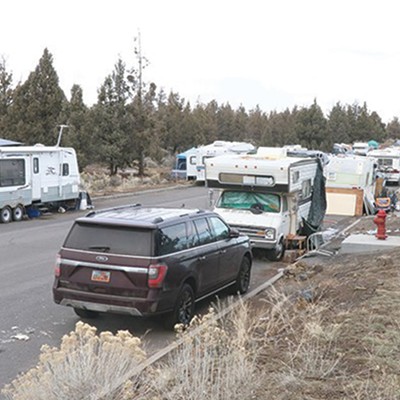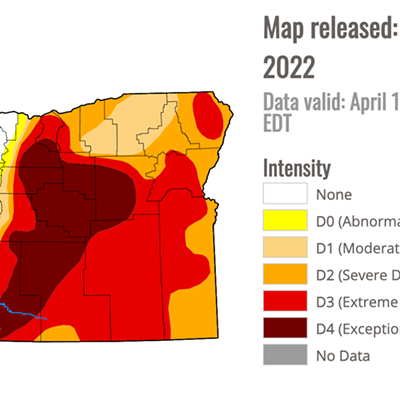In all the 65 years I've had the pleasure of living in Oregon (except for a short stint with The Nature Conservancy in Arizona running Ramsey Canyon Preserve) I somehow missed bumping into a most remarkable animal, the Sierra Nevada red fox.
The first I ever heard of this beautiful resident of the Oregon High Country was a recent email from LeeAnn Kriegh, author of the new field guide, "The Nature of Bend." Had she not sent the photos, I would have dismissed her sighting as just another report of the hundreds I've received on the eastern red fox, a very common alien resident in these parts.
The Sierra Nevada red fox, on the other hand, is something special, to the extent it can be red or gray, but in all phases it sports a big white blush on the end of its tail. So special, in fact, it's not even listed in the "Atlas of Oregon Wildlife" published by Oregon State University Press in 2001.
The tiny kit fox population way down in the far reaches of SE Oregon is mentioned, along with the alien eastern red fox and native common gray fox, but somehow, the authors missed the Sierra Nevada red fox that's been found throughout the Oregon Cascades for a long time.
Jon Nelson, curator of wildlife at the High Desert Museum, has captured multiple images of the Sierra Nevada red fox by several of his wildlife cameras placed throughout Central Oregon.
According to Wikipedia, it is also known as the High Sierra fox, and, "likely one of the most endangered mammals in North America." There are an estimated 29 adults near Sonora Pass in California, 42 in the Southern Cascades in California near Lassen Volcanic National Park, and an unknown number of individuals in five areas of Oregon.
The State of California banned trapping of the Sierra Nevada red fox in 1974 and listed the subspecies as threatened in 1980. They also were designated in Oregon as a sensitive species by the U.S. Forest Service.
Here's what the Oregon Department of Fish and Wildlife has to say about the species: "The USFWS declined to list the Sierra Nevada red fox under the Endangered Species Act due in part to research conducted in Oregon showing a significant extension of its range.
"An ongoing study of the Sierra Nevada red fox (SNRF) has confirmed their presence in the Oregon Cascades, specifically in the Mt. Jefferson, Mt. Washington, and Three Sisters Wilderness Areas. Additional samples from this study are being collected in the original study area and also throughout the Oregon Cascades, including Mt. Hood National Forest and Crater Lake National Park."
"Due to these findings, SNRF has been added as a Strategy Species in the 2015 draft update of the Oregon Conservation Strategy (OCS), which include those species with small, declining or unknown population levels that could be at risk and may be in need of conservation.
The ODFW study started as part of a forest carnivore survey by the Oregon Department of Fish and Wildlife, and working with the U.S. Forest Service, researchers set up bait, hair snares and cameras in a study from 2012 to 2014.
Remote cameras captured images of the rare fox which was originally thought to be the Cascades red fox that exists in Washington. Oregon also has the Rocky Mountain red fox in the northeastern part of the state and non-native lowland red foxes in much of the state. More than 700 photographs of SNRF were taken over the two-year project, and they were found at 11 of 41 bait stations throughout the Cascades study area.
The initial bait and camera project ended in June 2014, after which ODFW biologists met with biologists and seasonal employees with the U.S. Forest Service, Crater Lake National Park and the Confederated Tribes of Warm Springs to collect scat and other samples.
Preliminary DNA analysis of hair samples suggests the foxes are the native Sierra Nevada subspecies of red fox. Researchers are confident additional testing will answer more questions about these montane (mountain) red foxes.
Here's LeeAnn's story of her discovery of our "new" pal in the mountains: "I was celebrating Labor Day with a morning hike near Mt. Bachelor, and as I walked around a corner in the trail I came face to face with a fox that was standing no more than three feet from me.
"She (I'm guessing it was a she) looked at me with absolutely zero concern and then walked a few paces over to a rocky overlook. At first I was afraid to move for fear of frightening her off, so I just stood there in awe—I've never seen a fox in the wild before, and I can't say I've seen any wild animal that was quite so beautiful. She was smaller than I'd imagined a fox would be, with extremely thin legs and a narrow chest. But then that big, gorgeous, flowing tail!
"When I got home, I wrote to Jon Nelson (Wildlife bio at the HDMuseum) and sent a photo. The white-tipped tail made me think it was a Sierra Nevada red fox, and Jon confirmed it. What luck! I told him I should go buy a lottery ticket. I truly felt blessed to see such a rare creature, and not just to see it but to have the honor of watching it for a couple minutes, both of us silent, near to each other but in our very different worlds. I'll never forget the experience," LeeAnn recalled.
"But there's the darker side of the story—that people have been feeding SNRFs. When Jon told me that, I was devastated. Here we are, so incredibly lucky to have this rare, beautiful species in our backyards, and we're treating it with disrespect. I know people probably don't understand that they shouldn't feed wild animals, so we just need more education. But it's deeper too, at least to me: We need to let wild be wild.
"Wild animals don't need our handouts and hot dogs. What they do need is for us to nod our heads in recognition, give them the respect they deserve, and go out of our way to preserve and protect them."
Should you come upon someone feeding foxes, please ask them to quit; it's an open invitation for cougars to join in. The City of Sisters passed an ordnance prohibiting the feeding of mule deer within the city limits (which will go a long way to prevent cougar and man collisions.)
On the other hand, while you're hiking or riding in the high country should you come into contact with any fox, especially one with a big white blob on the end of its tail, please try and photograph it, but even if that fails, please send me a report regarding your observation to: [email protected]., and I'll send it on to Corey Heath at ODFW.


























